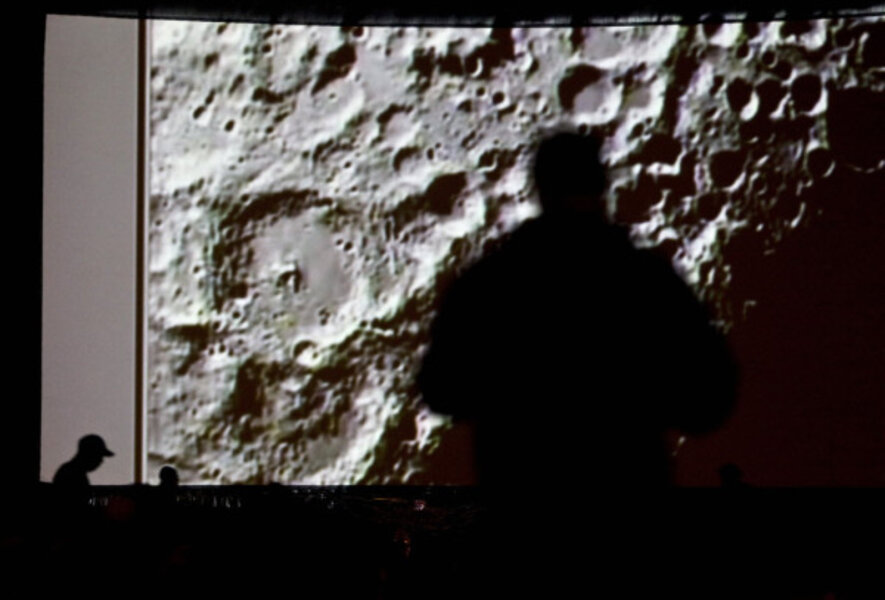The moon may hold 100 times more water than previously thought
Loading...
The moon's interior may harbor 100 times more water than previous estimates, according to a new study that took a fresh look at samples of moon rocks collected by Apollo astronauts nearly 40 years ago.
The researchers determined that the lunar water likely originated early in the moon's formation history, suggesting that it is, in fact, native to the moon.
Scientists at the Carnegie Institution's Geophysical Laboratory, and other colleagues, said it's likely that the water was preserved from the hot magma that was present when the moon began to form – some 4.5 billion years ago.
IN PICTURES: The full moon
They also think that the water, which is locked up in lunar rocks and material, is likely more widespread in the moon's interior than previous studies estimated. These findings now suggest that the lower limit for total water on the moon could be 100 times greater.
"When the rocks were first returned from the Apollo missions, it was pretty obvious that they were really dry," Francis McCubbin, lead author of the study, told SPACE.com. "A lot of people attributed the dry nature to something fundamental about how the moon formed. I think an estimate was thrown out there of less than 1 part per billion (ppb) water, because the presumption was that there was almost no water on the moon."
Tracking moon water
In 2008, research of volcanic glass beads brought attention to the fact that there might be more water in the moon's interior than scientists had previously thought. At the time, McCubbin and his colleagues were searching for water in lunar minerals, but at that point they had only models and calculations that suggested higher water content.
Since then, observations from unmanned probes from NASA and other space agencies have confirmed the presence of water in lunar material and water ice on the moon's surface.
For this new study, the researchers were able to compare their calculations to analyses of samples of Apollo moon rocks and a lunar meteorite from Africa.
"We combined the measurements with models that characterize how the material crystallized as the moon cooled," McCubbin said. "We found that the minimum water content ranged from 64 parts per billion to 5 parts per million – at least two orders of magnitude greater than previous results."
The research will appear in the online early edition of the Proceedings of the National Academy of Sciences on June 14.
Moon water from magma
In the new study, researchers located grains of the mineral apatite in thin sections from the moon rocks and meteorite. They used a technique called secondary ion mass spectrometry (SIMS), which allowed them to analyze the grains for a compound known as hydroxyl, which can be incorporated into apatite's chemical structure if the mineral crystallizes from magma that contains water.
The SIMS technique bombards the lunar samples with a primary ion beam that allows the researchers to separate the ions with a magnet, depending on the charge. From these measurements, the scientists inferred the amount of water in the apatite's source magma, which allowed them to extrapolate the result to estimate the total amount of water that is present on the moon.
"The numbers that we got matched the calculations that we had done almost perfectly," McCubbin said. "We were pretty happy about that."
The prevailing hypothesis is that the moon was formed from a giant impact event, when a Mars-sized object slammed into Earth. The ejected material from this collision then coalesced into what is presently the moon.
The results of the new study found that the moon's water was likely present in the hot magma from the impact as it started to cool and crystallize.
Yet, compared to Earth and Mars, the moon is still remarkably dry, said McCubbin.
"If we were to take all the water that is locked up inside the moon, and put it in a homogenous layer on the lunar surface, it would cover the moon to about a meter depth," he explained.
In comparison, if all the water that is locked up in Mars was put on the lunar surface, it would cover the moon to a depth of about 0.93 miles (1.5 km). And, if the same is done for all of the water inside the Earth, it would cover the entire lunar surface to a depth of 155 miles (250 km).
Still, the findings have significant implications that could alter current theories about lunar magma, and how the moon formed and evolved.
"It is gratifying to see this proof of the OH contents in lunar apatite," said lunar scientist Bradley Jolliff of Washington University in St. Louis. "The concentrations are very low and, accordingly, they have been until recently nearly impossible to detect. We can now finally begin to consider the implications – and the origin – of water in the interior of the moon."
- Images - Future Moon Bases
- Video - Water on the Moon: Hydrogen, Oxygen and Energy
- Tons of Water Ice Found on the Moon's North Pole
IN PICTURES: The full moon





